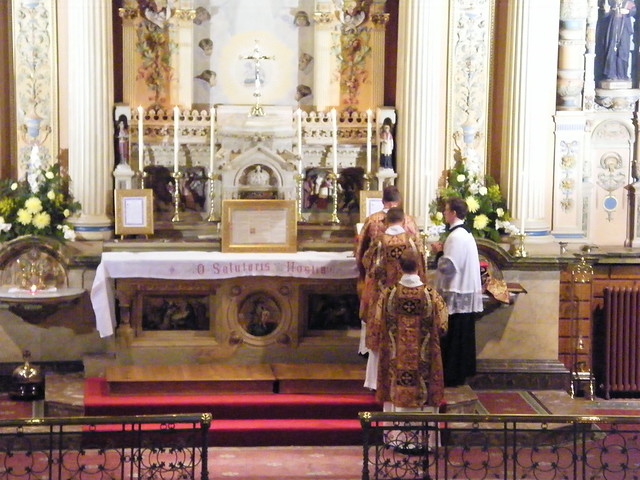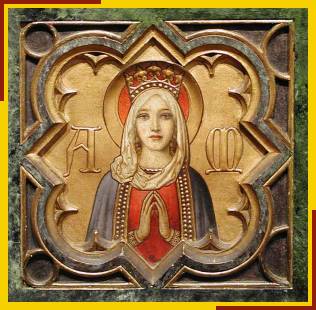Today, along with the feast of the Presentation, is perhaps one of my favourite feasts. It is perhaps one of the richest in theology, symbolism and devotion, as the texts, especially of the office, prove.
Why does this feast occur on this day? It is an odd time of year to sing Passion-tide hymns. Today, according to legend, commemorates the day when the emperor Heraclius carried the Cross back to Calvary, it having been stolen by Chosroes, the emperor of Persia. He, having been safely defeated (or rather murdered by Siroes, his son), was out of the way, and the Cross could be brought back. However, when Heraclitus was the gate which led to Calvary, he found himself rooted to the spot, unable to advance. The bishop of Jerusalem (Zacharius) then pointed out to him that if he wished to follow Christ's road to Calvary, he should imitate Him in His poverty and humility. So Heraclius stripped himself of his robes of state, which he happened to be wearing, and took up the Cross, and carried it easily to Calvary, then put it back where it belonged. Truly, we should glory in the Cross of Christ. And nothing else.
As I said, the Office for today gives us Venantius Fortunatus' three great hymns to sing once more: Vexilla Regis, Pange lingua & Lustra sex. These, I think, are three of the deepest hymns the church has at her disposal. When sung in Passion-tide they have an understandably doleful air to them; but today the glory of the Cross shines through. Today it is not the tree of shame and humiliation, but, because of Christ's redeeming work, it is the tree of glory. The hymns portray this beautifully, and use a very ancient motif, which still persists in many places, of personifying the Cross: they speak not only of, but to the Cross. (I suppose much in the way I speak to recalcitrant photocopiers, but with a degree more tenderness and without threats of violence if it doesn't start doing what I want it to).
Thou alone wast counted worthy,
This world's ransom to uphold;
For a shipwrecked race preparing
Harbour, like the Ark of old;
With the sacred Blood anointed
From the smitten Lamb that rolled.
In this verse alone, we see a great deal of depth in one word: the Ark. This takes us down the path of the various things foreshadowed, fulfilled & completed in the Cross; beginning with the Ark, the forerunner of the church: made of wood, like the Cross, it gave safety in the floods, so to, the Cross gives us safe harbour through the storms, changes and chances of the world (a religious sister, on the day I was received, told me that the church was truly like the ark: the stench inside would be unbearable, were it not for the floods outside. I think there is a little truth in this). The old testament reading in the ordinary form gives us Moses and the serpents, another type of the Cross: Moses staff, with the serpent entwined about it gives healing to those bitten by the snake, by their gazing on it. In a final twist against the spoiler, he is outwitted by the Cross: we can see the Devil dogging the footsteps of Christ on the way to the Cross, and it is easy to imagine the serpent entwining itself about the base of the Cross in a final attempt to thwart the inevitable. This is alluded to Christ Himself in conversation with Nicodemus in John 3: the Son of Man must be lifted up as Moses lifted up the serpent. We also see in the wood of the Cross the wood of the table of the Last Supper, the wood of the barque of Peter.
The motto of the Carthusians is Stat crux dum volvitur orbis- the Cross is steady as the world turns. I would go further and say that the world turns around the Cross: there are few sensible historians, I think, who would deny that in those three hours Christ hung on the Cross, the world changed forever. No event had the same effect on the world as when an itinerant preacher in a back-water of the Roman Empire was put to death. The whole world, even the whole universe, turns on that one point fixed point in history.
+Fulton Sheen was fond of pointing out the threes: 30 years our Lord was hidden in Nazareth. Three years he preached. Three hours he suffered. And on the third day He rose again. Those 33 years changed everything. Those three hours proved beyond a doubt that God so loved the world.
Therefore, to quote St. Paul and the authorised version, it behoveth us to glory in the Cross of our Lord Jesus Christ.
O cross, our one reliance, hail!
Still may thy power with us avail
To give new virtue to the saint,
And pardon to the penitent.
On a personal note, today is also a glorious day, not only for the implementation of Summorum Pontificum, but also it the anniversary of my acting as Subdeacon for High Mass for the first time.

